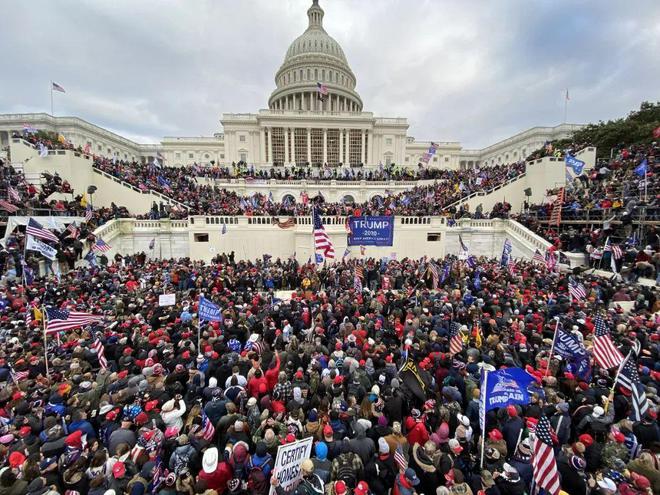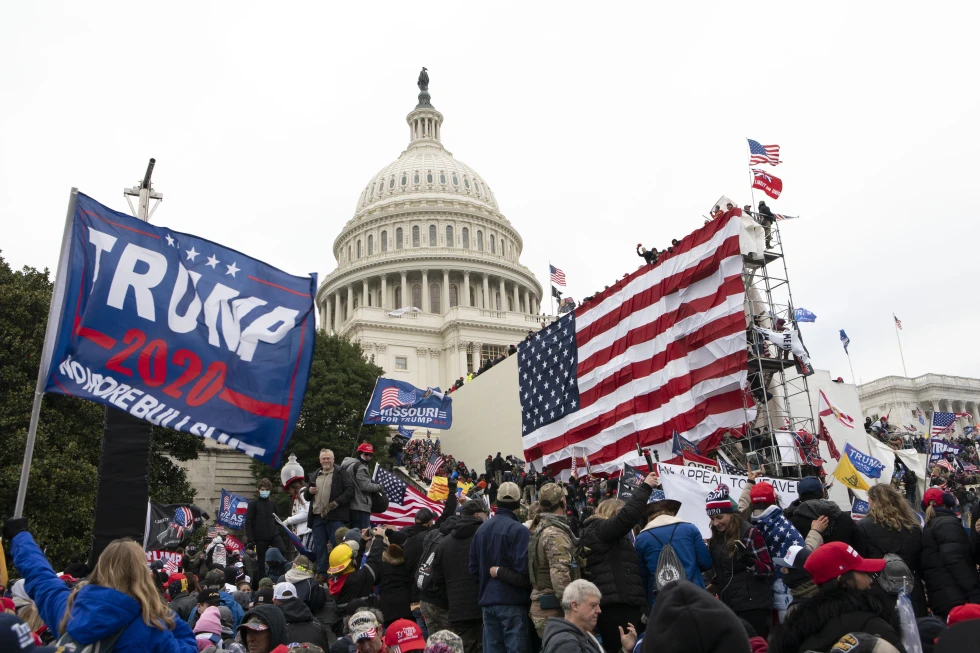The dissemination of misinformation and conspiracy theories has become increasingly prevalent in today’s society, particularly in the realm of social media.
One such example of this is the claim that a video clip shows liberals dressing up as supporters of former President Donald Trump before taking part in the Jan. 6 attack on the U.S.
Capitol, thereby proving that the riot was an inside job. However, upon closer examination, it becomes evident that this claim is false and lacks any factual basis.
The video clip in question was actually filmed by comedian Walter Masterson and content creator Peter Scattini, who posed as Trump-friendly reporters on Jan. 6, 2021, with the intention of interviewing people at the “Stop the Steal” rally that preceded the Capitol attack.
Both men posted videos showing extensive footage from the day’s events, which include the shot of them donning Trump paraphernalia and patriotic garb in an effort to blend in with the crowds.
It is important to note that they clearly explain in the videos that they went to the rally to create comedic content and express disbelief about what happened.
Therefore, the notion that this video clip serves as evidence of liberals dressing up as Trump supporters to partake in the Capitol attack is unfounded.
It is essential to confront the dissemination of false information, particularly in cases as serious as the Jan. 6 attack on the U.S. Capitol.
The facts surrounding this event are clear: hundreds of individuals have been convicted or pleaded guilty for their role in the riot.
However, despite this, more than three years later, some individuals on social media continue to perpetuate the baseless claim that the attack was orchestrated by the government itself.
The video clip in question is a prime example of how misinformation can be manipulated and distorted to fit a particular narrative.
The individuals behind the video, Masterson and Scattini, were simply engaging in a form of comedic content creation and did not have any involvement in the events that transpired at the Capitol on Jan. 6, 2021.
It is crucial for individuals to critically evaluate the information they encounter on social media and to refrain from perpetuating false claims that lack any factual basis.
In conclusion, the claim that a video clip shows liberals dressing up as supporters of former President Donald Trump before taking part in the Jan. 6 attack on the U.S.
Capitol, thereby proving that the riot was an inside job, is unequivocally false. The individuals behind the video were engaging in comedic content creation and did not have any involvement in the events that transpired at the Capitol.
It is imperative for individuals to exercise critical thinking and discernment when encountering information on social media, particularly in cases as serious as the Jan. 6 attack.
By doing so, we can work towards combatting the spread of misinformation and promoting a more informed and responsible online discourse.
The recent events surrounding the January 6th Capitol attack have brought to light the disturbing trend of misinformation and misinterpretation of footage circulating on social media platforms.
The clip in question, showing two men disguising themselves as Trump supporters, has been used to propagate the false narrative that liberals were behind the attack.
This kind of misinformation is not only damaging but also dangerous, as it seeks to create division and spread distrust among the public.
The man on camera can be heard instructing the other person to blend in and have a visual identifier, implying that they are trying to disguise themselves as Trump supporters.
The Instagram posts that shared the clip added captions that falsely claimed the men were liberals disguising themselves to attack the Capitol.
This misinformation has been widely shared and has garnered significant attention, with one post receiving over 92,200 likes.
It is crucial to address the spread of misinformation on social media and to emphasize the importance of fact-checking and critical thinking.
The clip in question does show two men disguising themselves, but it is essential to understand the context and the actual intent behind their actions.
In this case, the men were not involved in the Capitol attack, and there is no evidence to support the claim that liberals were behind the events of January 6th.
The impact of misinformation on social media cannot be understated. It has the potential to fuel division, incite violence, and erode trust in institutions and the media.
The responsibility falls on both social media platforms and individual users to verify the accuracy of the content they share and consume.
Fact-checking organizations and reputable news sources play a crucial role in debunking false claims and providing accurate information to the public.
In addition to fact-checking, it is essential for users to approach content with a critical mindset. This means questioning the source of the information, considering alternative perspectives, and being mindful of the potential biases and agendas behind the content.
Critical thinking skills are invaluable in navigating the vast amount of information available on social media and discerning truth from falsehood.
Furthermore, social media platforms have a responsibility to address the spread of misinformation on their platforms.
This includes implementing measures to detect and remove false content, providing users with tools to report misinformation, and promoting media literacy and critical thinking skills among their user base.
While these efforts may not completely eradicate misinformation, they can significantly mitigate its impact and help create a more informed and responsible online community.
In conclusion, the spread of misinformation on social media poses a significant threat to public discourse and societal cohesion.
The recent misinterpretation of footage showing two men disguising themselves as Trump supporters is a stark example of the potential harm that misinformation can cause.
It is essential for individuals to approach content with a critical mindset and for social media platforms to take proactive measures to address the spread of false information.
By working together to promote media literacy and responsible sharing, we can mitigate the impact of misinformation and foster a more informed and united society.
In the realm of journalism and media, the line between satire and reality can often become blurred, leading to ethical quandaries and moral introspection.
The recent events surrounding the “Stop the Steal” rally in Washington, D.C., have brought to light a controversial instance where two individuals, Masterson and Scattini, assumed the roles of Trump-friendly reporters to capture footage for comedy videos.
However, what transpired during and after the rally forced them to confront the stark seriousness of the situation, prompting them to grapple with the ethical implications of their actions.
This essay aims to delve into the complexities of this scenario, exploring the boundaries of satirical reporting, the impact of unforeseen events, and the ethical responsibilities of content creators in the digital age.
The “Stop the Steal” rally held in the aftermath of the 2020 United States presidential election served as a focal point for fervent supporters of then-President Donald Trump.
The rally, intended to voice grievances over alleged electoral irregularities, culminated in a violent breach of the U.S. Capitol, shocking the nation and the world.
Amidst the chaos, Masterson and Scattini, under the guise of comedic reporting, sought to capture the rally’s essence through satirical lenses, only to find themselves confronted with the harsh realities of the unfolding events.
Masterson and Scattini, self-identified as actors and creators of comedic content, embarked on their venture with the intention of producing light-hearted, humorous videos.
Their initial outlook was one of jovial observation, expecting to derive comedic material from the rally’s participants.
However, as the day progressed, the atmosphere shifted, and the gravity of the situation became undeniable.
Both individuals expressed their surprise and disbelief at the unfolding events, highlighting the stark contrast between their initial expectations and the harsh reality they encountered.
The ethical implications of this situation are multifaceted and warrant careful consideration. Firstly, the act of assuming false identities to gather footage raises questions about journalistic integrity and the responsibility of content creators.
While satire has a long-standing tradition in media, the portrayal of fictitious personas in a sensitive and politically charged environment demands a heightened level of ethical awareness.
The unforeseen escalation of events at the rally further complicates the matter, as the intended comedic narrative clashed with the stark seriousness of the unfolding situation.
The emotional aftermath experienced by both Masterson and Scattini underscores the profound impact of witnessing a tumultuous event firsthand.
Their candid admissions of being shaken and emotionally affected by the day’s events reveal the human dimension of their experience.
Scattini’s account of breaking down in a Wendy’s bathroom and the palpable sense of disbelief conveyed by Masterson serve as poignant reminders of the profound impact of witnessing a crisis.
The aftermath of the Capitol riot has seen a wave of legal actions, with over 1,230 individuals facing federal charges, ranging from misdemeanors to felonies.
The severity of the legal consequences underscores the gravity of the events that transpired, further emphasizing the dissonance between the initial intent of comedic reporting and the unforeseen reality.

The case of Masterson and Scattini at the “Stop the Steal” rally serves as a compelling reflection on the ethical dilemmas inherent in satirical reporting and the unanticipated weight of witnessing a crisis.
It prompts us to contemplate the ethical responsibilities of content creators, the moral complexities of navigating satire in sensitive contexts, and the enduring impact of unforeseen events.
As we navigate the evolving landscape of media and journalism, this case stands as a poignant reminder of the need for ethical introspection and the recognition of the profound human dimensions underlying every narrative.
In conclusion, the events surrounding the “Stop the Steal” rally and the subsequent reflections of Masterson and Scattini compel us to consider the ethical complexities of satirical reporting, the impact of unforeseen events, and the moral responsibilities of content creators in the digital age.
This case serves as a poignant reminder of the enduring ethical dilemmas inherent in media and the imperative of ethical introspection in the pursuit of truth and storytelling.
